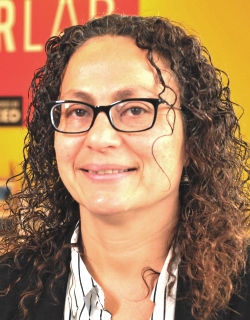

Professor, Electrical Engineering, University of Ottawa
Director, Centre of Entrepreneurship and Engineering Design (CEED)
NSERC Chair in Entrepreneurial Engineering Design
As demand rose around the world for personal protective equipment (PPE) and medical supplies during the COVID-19 pandemic, the maker community—a community of people worldwide that offer the space and equipment to invent, design, test, prototype, and bring ideas to life—quickly rallied to find ways to use open-source designs to answer the calls from medical professionals and frontline workers.
For example, the Centre for Entrepreneurship and Engineering Design (CEED) at the University of Ottawa is just one such facility at higher education institutions across Canada currently producing protective equipment for healthcare workers and others.
“We were feeling helpless at the start of the COVID-19 crisis and we weren’t sure what to do,” says Hanan Anis, NSERC Chair in Entrepreneurial Engineering Design at the University of Ottawa and director of the CEED. “We looked to Italy, saw doctors without shields, and my first thought was, ‘we can do this.’”
She and her students and employees quickly refocused their normal work to instead create life-saving PPE for frontline workers and medical equipment. They went online, modified existing designs, and within a few hours, started printing it using the Makerspace’s 3D printers. They then worked with a number of local hospitals to improve their initial design and make it meet the needs of different health care workers.
After posting on social media that shields would be available, emails from medical professionals and others looking for this equipment came in en masse, Anis said. Working 24/7, they were able to print 300 shields per day. By June 5, 2020, they had distributed more than 9,050 reusable face shields to more than 35 institutions in Ottawa and surrounding areas, including hospitals, clinics, hospices, and long-term care homes.
Now Anis and her students are looking at a low-cost ventilator prototype, knowing that they could be needed should the medical system be overwhelmed here or in other countries. Like the global Maker community, they are looking to share their designs with other communities so anyone facing a shortage could produce the equipment and devices locally.
“We’re trying to be a bit ahead of the curve,” Anis explains. “We’re not trying to make money, we’re not trying to sell these things. Instead of sitting helpless, we’re trying to do something that might turn out to be useful for someone.”
This desire to help is at the root of what it means to be an engineer, Anis says. Ultimately, the role for engineers during a pandemic is the same as it is at any other time, and is enshrined in their professional obligation: how to best protect the public. Different types of engineers have different skill sets and will do that in different ways, Anis explains.
“We know very well that this sort of crisis will define our generation,” she says. “We need to do something. Engineers build stuff. We tell students that our role is to serve society. Whether it’s the ventilator, or the shield, it’s the little piece that we can do to help. I’m sure that others can do many things. We all need to look at our skill sets and figure out what we can do.”

